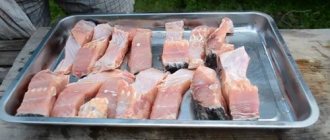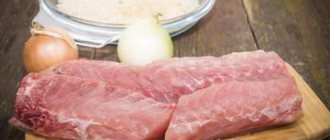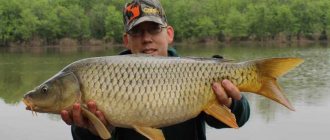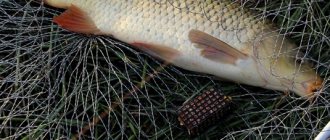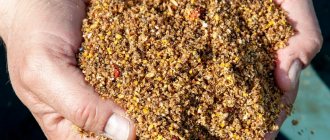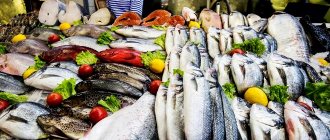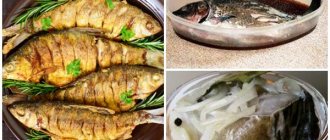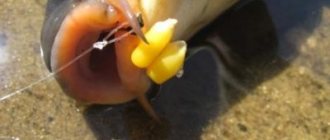Description
The main difference between fish is their lifestyle. Carp is accustomed to life in freedom, in natural rivers and reservoirs; carp is considered an adult species of domestic carp. The subspecies belongs to the carp family, to the order of carp-shaped fish with the ray-finned class.
A common feature is that fish do not have a stomach, which forces them to constantly move in search of food. This anatomical feature helps to increase in size. There are units that reach unimaginable dimensions. An individual is listed in the Guinness Book of Records; its age is 30 years, the weight of the “old man” is 34.85 kg with a length of more than 150 cm.
Carp and carp have the same sense of smell. This is due to the absence of a stomach, which helps to sense a living creature within a radius of 10 meters. The sense of smell is expressed in the outgrowths on the upper lips and mustache. The tubercles function as taste buds.
Important point! Carp differ from carp in additional sensory zones - cells located evenly throughout the body, due to which the radius of touch and smell is increased.
Both species of vertebrates have good vision, which allows them to control movements and see the situation on the shore. Carp prefer a rough bottom with rich vegetation, snags and reeds. Rough water scares fish.
Representatives are constantly trying to find food. They are unpretentious in food; plants or snails and small fish are suitable. Cannibalism is not a problem. Food is determined by the temperature of the habitat. In warm waters there is little living life, the diet consists of plants, in cold waters, on the contrary, there are more living organisms.
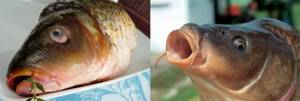
Carp (left) and Carp (right)
In winter, aquatic animals prefer to save energy by staying in one place and practically not moving.
To learn more:
Is a bream a small bream or not?
Puberty begins at 3 years of age. They prefer to lay eggs in thickets of aquatic plants. Spawning time begins at a temperature of + 20°C. Small individuals appear after 80–90 hours. During spawning, it is especially difficult to distinguish carp from carp.
We wrote more about carp here.
What types of carp are there?
Domesticated carp were bred from carp for easy breeding for fishing purposes.
- Common carp - has golden or light brown scales.
- In mirror carp, scales on the body are located in places - the area of the back, caudal fin and gills. Catching mirror carp is a real exotic experience for an angler.
- Naked carp can hardly be confused with carp, since it completely lacks scales. In natural habitats, it practically does not survive.
Differences
In science, these are subspecies of the same fish. Carp is its wild form, and carp is its domestic form. However, carp and carp have a number of differences.

Carp (left) and naked carp (right)
Appearance
It is difficult to distinguish representatives externally; the difference between carp and carp is in the scales. The first one is completely covered with large particles of bronze.
There are subspecies of cyprinids that are partially covered or completely defenseless:
- Naked type - has no scales at all.
- Mirror type - a couple of rows, on the side and near the fin.
- Frame type - next to the anal fin and along the length of the dorsal fin.
After 38-40 months, the carp increases in length, and its domestic brother gains width.
Scientists have identified the main directions for carp selection:
- An individual with frequent reproduction, rapid growth and low living requirements.
- In the form of a pet. The emphasis is on Asian countries.
The carp's scales are large and difficult to clean. To achieve this, breeders tried to breed a representative of the mirror type.
Naked carp are considered unable to survive in the wild and are therefore the least common carp. Mirror is considered the first number in selection due to the natural removal of scales.
Interesting! Most fishermen believe that the head of a carp is larger than the carcass.
Carp are distinguished from carp by the shape of their heads. The former have a bulge at the intersection of the dorsal scales and the head. Carp is not marked with such a feature.
And also the length has a limit:
- Carp up to 1 meter;
- Carp up to 1.5 meters.
Area
Both fish prefer to move along the bottom, where there is more food. The diet is no different.
To learn more:
Is a bream a small bream or not?
Carp is a fish accustomed to living in a living river, powerful and fast. The vertebrate needs to struggle throughout its life, which affects its behavior - caution and excessive timidity. Catching a carp is a real achievement for a fisherman; you will have to exert maximum skill and patience.
Carp are lovers of quiet and calm places where the water is still. At an early age it becomes the largest aquatic animal in the pond. It has no rivals, which allows you not to fear an attack and loosen your grip.
Differences in habitat and habits
The difference in the habitat of these representatives of the carp family is significant. The first is a river species that inhabits deep areas of reservoirs:
- whirlpools;
- return;
- pits;
- ditches.
Loves strong places with large flooded trees, their trunks or branches. Not afraid of currents, it can go out onto the riverbed, examining riffles and dumps with a shell bottom for the presence of food.
Carp inhabit mainly closed water bodies - ponds, lakes, quarries. In some regions of our country it is released into rivers, but even here it prefers places with slow flows. Loves shallow and medium depths, goes to the pits in winter or at midday on a hot summer day.
Since the carp is a wild representative of the ichthyofauna, it leads a secretive lifestyle, is careful, and sensitively reacts to extraneous noises. When catching it, you should observe silence and the rules of camouflage, otherwise you can’t count on a bite from this river resident.
Recommended reading: Fish ide
Carp is a cultivated inhabitant of closed reservoirs. He is accustomed to noise and movement on the shore. In paid ponds it is fed abundantly, so the fish is always full and moves little. However, fishing pressure does its job, and with age she becomes experienced, careful with baits, and sees coarse rigs and thick fishing lines well.
The nutritional composition of these representatives of the ichthyofauna may differ. The menu of carp is dominated by food of animal origin - bottom invertebrates, mollusks, small crustaceans. In conditions of poor food supply, especially in spring, it can eat the eggs of other fish and attack fry.
Tip: Carp in warm water prefer fruity and sweet aromas.
Carp prefers plant foods. Animal prey is present in its diet mainly in spring and autumn. Therefore, when fishing for it, fishermen use baits made from cereals, dough, peas and corn with the addition of various aromatic ingredients.
The benefits and harms of meat
Carp meat contains many macro and micro nutrients: chromium, iron, and magnesium. There are 98 calories per 100 grams of fish, 42 grams of proteins and class A nutrients.
There is practically no natural fat in meat, carbohydrates are completely absent. Carp meat is an excellent dish for anyone who wants to lose weight!
A diet containing carp meat helps prevent:
- Gastritis.
- Heart and vision problems.
- Excess weight.
Meat is popular in the Middle Kingdom due to its healing properties. The taste of fish depends on the environment where it was caught. Dirt cannot be removed; heat treatment and water rinsing will not correct the situation.
Origin and features
Carp has a more ancient origin than carp. It was caught and served on the table of high-ranking persons back in Ancient China. Later, it was possible to artificially breed carp, which easily adapted to existence in small ponds. In the Middle Ages it was brought to Europe, where it gained unprecedented popularity.
It is for this reason that it is generally accepted that the carp is the wild ancestor of the carp.
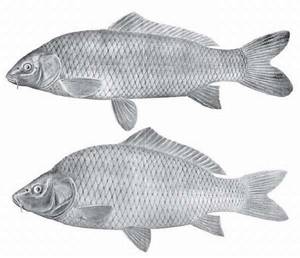
The first picture in the photo is carp, followed by carp. On a note! However, researchers agree that carp and carp are 2 types of fish of the same species.
According to scientific classification they include:
- class - ray-finned,
- order - carp-like,
- family - carp,
- genus - carp.
Since the carp was obtained artificially as a result of the domestication of carp, the individuals are indeed very similar to each other. But there are several factors by which you can still find differences.
Which is better - carp or carp
It is very difficult to say exactly why carp is better than carp and vice versa. If we talk about taste, then in the fishing community it is pleasant to think that carp meat is in the lead over carp. But it is almost impossible to find significant differences in taste. It all depends on the method of preparation. Carp is better suited for frying, baking, stewing, smoking, but carp is better for boiling and salting.
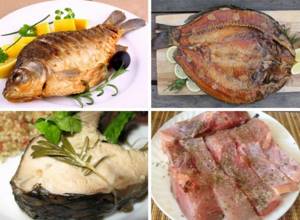
The former are often used for preparing hot dishes, and the latter for cold dishes. The meat of both representatives will go well with mushrooms, vegetables and fruits. An unusual but good addition to fish dishes would be nuts, grapes, and dried fruits. The combination of ingredients makes the taste of the dishes piquant and original.
They react to:

Carp and carp are not the same fish. There are differences between them. Specimens are distinguished according to various characteristics, the main one of which is habitat. You can catch carp in stagnant bodies of water, and carp in rivers and other flowing waters.
Scientific classification
Before you understand whether carp or carp is tastier, you should decide what kind of fish it is and how it is classified by experts. The main similarity of these waterfowl can be considered that they live in fresh water, moreover, they belong to the same order of Cyprinidae and both have small mustaches that distinguish them from other representatives of the order. It is kinship that unites them, first of all, and as for the differences, they exist, albeit insignificant. First of all, I would like to pay attention to the habitat: the voracious carp can be caught in stagnant water, including newfangled paid ponds, and as for the second test subject, he usually lives in reservoirs with running water.
Now, as for the second version regarding origin and kinship, it is more interesting. If you want to know which is better, think about whether we are talking about the same fish. At least, this is the opinion of many researchers who claim that carp is nothing more than common carp, and this is a domesticated carp. How can you talk about the differences between the same fish? We are inclined to believe, and take it as an axiom, that these are different species, and besides, they have external differences.
What is the difference between carp and carp, what is the difference and which is better
The dream of almost every fisherman is to catch fish from the Carp family. Dishes made from such specimens will be a wonderful decoration for the dinner table. Most families will be happy with such tasty and healthy dishes. But not every person, and even an experienced fisherman, can discern a clear difference between species of the same genus, i.e. what differences exist between carp and carp. Read further in the article about the main features of the above-mentioned representatives of the aquatic world, as well as which one has more advantages over the other.
What does carp look like?
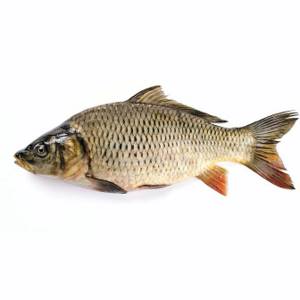
This is the most ancient representative of this family. Its long and tall body is covered with evenly large scales of golden yellow color, each of which has a black frame.
The color of carp's scales is not uniform. On its dorsal part the scales have a bluish tint, and in the abdominal area they are quite light. The wide caudal fin has a reddish-brown tint, all other fins are gray.
Its body is elongated with a slight thickening in the front part and reaches a length of about 1 meter. The older the fish becomes, the more massive its body and the more intense the color.
The large fin on the back runs the entire length of the body and has a serrated ray. The same ray, but smaller, is located on the anal fin.
The muzzle is pointed, with a clearly defined gill part. At the bottom of the head there is a retractable mouth, the chewing plate is quite clearly defined. There are antennae at the corners of the mouth.
Carp is unpretentious in food, it is omnivorous. It can feed on plant (algae, coastal greens) and protein (roe of other fish, small insects and their larvae, worms, etc.) food. With a small amount of food, the carp shows signs of a predator and its diet may include smaller fish. Its juveniles feed on plankton and organic bottom sediments.
The average weight of an adult carp is 3-4k g. But there have been cases when a carp weighing about 30 kg was caught. His average life expectancy is 30-35 years and he can be called a long-liver. Large specimens are still caught today, but extremely rarely. The fish grows quickly; in the first year it reaches a length of 10 cm.
The carp has a peculiarity: in winter it falls into a state of torpor. During this period, he eats nothing and hardly breathes. It remains in this state until the first thaw.
This fish has good eyesight. He is able to see moving fishermen and an insect that has fallen into a pond. It has been noticed that the carp is able to bypass all set traps well, notice small movements of the fishing rod, and when the net approaches, it buries itself in the silt.
According to many fishermen, the quality of its bite depends on the weather and time of day. For example, during prolonged heat or cold, he hides. It is passive even when the weather changes quickly, and the morning is considered the best time to catch it.
Individuals of this species are divided into the following subspecies:
- Amur (Amur-Chinese).
- Aral.
- Vietnamese.
- European.
This division is based on their distribution area.
Appearance and structure: what is the difference between carp and carp?
However, upon careful examination, you will notice that the carp has a more elongated body, which is due to its habitat - it prefers bodies of water with a current, rivers, where it is necessary to overcome its resistance when searching for food. At the same time, it grows in length much longer than carp, which, upon reaching a certain length, begins to “get fat” , increasing in width. With the same mass, the ancestor of the carp will have greater length. Each scale of the carp has a dark frame, while on the carp it has a uniform color.
Fish nutritional features
The common carp is a type of stomachless fish, so it is able to feed almost without stopping.
- After a period of hibernation until mid-June, the carp feeds mainly on aquatic vegetation: young stems and leaves of plants, for example, reeds, cattails, egg capsules, seeds of terrestrial and aquatic plants that accidentally fell into the water, as well as larvae, frog eggs and fish eggs.
- When steadily warm days arrive, some part of the aquatic flora remains on the menu of common carp, but is actively replaced by various animal organisms. The fish begin to eat worms, caddis flies, molting crayfish, small leeches, as well as various snails: pearl barley, cattails and pond snails.
- With the arrival of autumn, carp begin to ignore coarsened plant food, and eat food exclusively of animal origin: crayfish, beetles, daphnia, water striders.
- Carp fry, which are about 2 weeks old, eat bloodworms and various microorganisms that can be found in the silt.
Carp grows quite quickly. The rate of its growth will depend on the feeding conditions, the duration of the warm period with the water temperature in the reservoir above 20 degrees, as well as on the richness of the food supply. The fish feed most intensively at temperatures from 25 to 29 degrees, and stop feeding at temperatures below 8 degrees.

